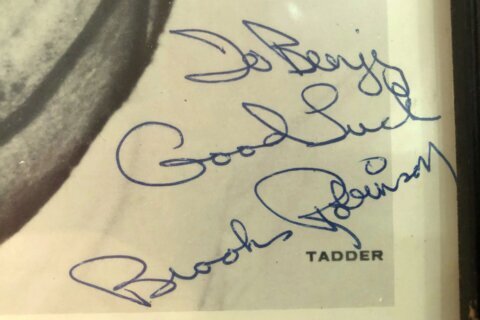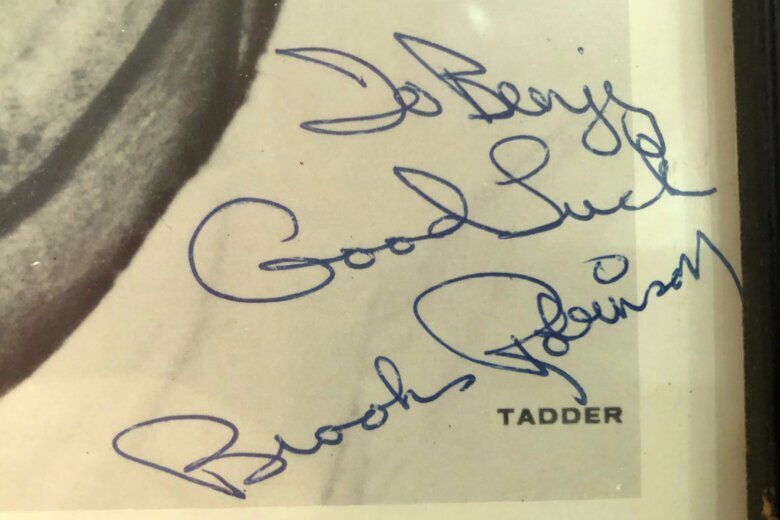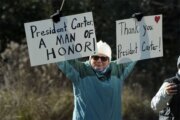
ROCKVILLE, Md. (AP) — Hall of Fame third baseman Brooks Robinson died Tuesday at the age of 86. Among his many fans in Maryland during his playing days was Ben Walker, a young left-hander who would go on to cover baseball for The Associated Press for more than 40 years. Walker retired in March, but he wrote this appreciation of Robinson for the AP from his childhood home after hearing the news.
___
We still have a charmed patch of grass in our backyard, plucked from the very spot where Brooks made that play.
Growing up in Maryland in the 1960s, Brooks Robinson was a god. Every kid wanted to wear his No. 5. Even us lefties tried to play third base like him.
We imitated his aw-shucks Arkansas twang. We copied his relaxed, shoulders-bouncing jog off the field. If we could’ve worn a short-brimmed batting helmet like he did, we would’ve.
I was in fourth grade in 1966 when Mrs. Rogers gave our class a project to teach us how the post office worked. We were supposed to write a letter to someone and have them write back. Most students wrote to their grandparents or a classmate.
But I wrote to my beloved Baltimore Orioles, asking for Brooks Robinson’s autograph.
Understandably, I didn’t get anything back. So a few weeks later, my mom wrote to the team president, explaining that her son was in danger of getting a failing grade. She also added that I was a promising, 8-year-old pitcher and would never play for the Orioles if they didn’t at least write back saying they got my letter.
Within days, a large envelope came to our mailbox in Rockville. Inside, a beautiful glossy picture of Brooksie with this signature: To Benjy. Good Luck. Brooks Robinson.
I have it in a frame now, a cherished part of my childhood.
That 1966 season was magical. We’d go hours early to Memorial Stadium to watch infield practice, mesmerized as Brooks made perfect throw after perfect throw to big Boog Powell at first base.
Boosted by the great Frank Robinson, the elegant Paul Blair and the smooth Jim Palmer, the Orioles won their first World Series championship. The famed picture of Brooks leaping across the diamond toward Dave McNally after the final out of sweeping the Dodgers, Brooks’ sheer exhilaration, we all wanted to be him that October afternoon.
Five decades after I moved away from Maryland, my mom has preserved the door to my boyhood bedroom. It is covered with sports decals from back then and features a “Year of the Bird” sticker from that year. My friend KG, she calls it “the shrine” — I kind of feel that way now, with Brooks gone.
In the 1970 World Series, the whole baseball world got to see what we’d been watching for years in Baltimore.
My dad took me out of school to go to the clinching Game 5 against Cincinnati. We moved down from the upper deck in the late innings with the Orioles way ahead. We were sitting behind Baltimore’s third base dugout when Brooks cemented his MVP performance by making a diving, backhanded catch on a liner by Johnny Bench.
Moments later, it was over and fans rushed onto the field to celebrate. My dad gave me an approving nod. Go ahead.
So I ran out there, too. And I had my spot picked out — I went to the edge of the grass near where Brooks landed in foul territory after thwarting Bench, and pulled up a small plot of sod.
That night, we planted it in the backyard, near an oak tree. I wish I could say it was the shiniest, frothiest, greenest piece of grass of all time. It wasn’t. That didn’t matter, it was where Brooks had been.
I’m sure the remnants of the original sprouts are long gone. But we still point toward the spot, knowing the legacy of Brooks and certain our appreciation for what he meant will grow there forever.
Parents in the neighborhood often praised Brooks as much for his humility as his home runs. I saw that first-hand in 1983 when I was preparing to cover his first-ballot induction into the Hall of Fame.
I called him to arrange a phone interview and naturally told him I’d grown up cheering for him. Brooks said if it was easier, we could talk in person. He’d be at a Crown gas station in suburban Baltimore that weekend — he did promotional work for the company — and invited me down from New York to join him.
For an hour that Saturday, he sat under the blazing sun in a beach chair between the gas pumps, no handlers around him. Signing autographs, shaking hands and telling stories, he didn’t give off a single sign of being such a huge, revered star.
The only hint came in the way people approached him, as if they were greeting the Pope. It took all of about 3 seconds for Brooks to even the playing field, making them feel as if they were chatting with their next-door neighbor.
Without a doubt, he was the nicest, kindest ballplayer I ever met.
A few days ago, I was playing pickup softball in Central Park. Standing at third base during batting practice, a guy hit a hot shot at me and I dodged out of the way, not wanting to get zinged.
“You’re no Brooks Robinson!” an old-timer playfully shouted.
That’s for sure. On and off the field, there was only one Brooks Robinson.
___
AP MLB: https://apnews.com/hub/MLB
Copyright © 2025 The Associated Press. All rights reserved. This material may not be published, broadcast, written or redistributed.








